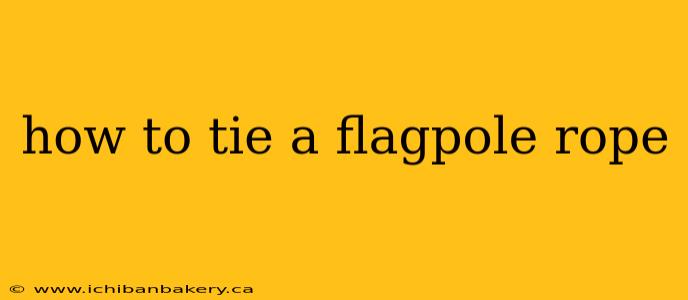Meta Description: Learn how to properly tie a flagpole rope with our comprehensive guide. We cover various knots, including the bowline, clove hitch, and figure eight, providing step-by-step instructions and safety tips for secure flag hoisting. Ensure your flag flies high and safe with our expert advice! (158 characters)
Understanding Flagpole Rope and Knots
Before diving into the knots, let's discuss the importance of choosing the right rope for your flagpole. Nylon or polyester ropes are generally preferred for their strength and durability. Avoid ropes that are frayed, weakened, or excessively worn. A rope in poor condition can snap, potentially causing damage or injury.
A sturdy rope is only half the battle; securing it correctly is equally crucial. Several knots are suitable for securing a flag to a flagpole, each with its own advantages and disadvantages. We will focus on three popular and reliable options: the bowline, the clove hitch, and the figure eight.
Knot Tying Techniques: Step-by-Step Instructions
1. The Bowline Knot
The bowline is a classic knot known for its strength and ease of untying, even after being under load. It forms a closed loop that won't slip or tighten unexpectedly.
Steps:
- Form a loop: Make a loop near the end of the rope, keeping the working end (the end you're manipulating) to your right.
- Pass it over: Bring the working end up and over the standing part (the main length of the rope).
- Through the loop: Pass the working end through the loop that you formed initially.
- Tighten: Pull both ends gently to tighten the knot.
Image: [Insert an image here showing the steps to tie a bowline knot. Optimize the image for web use.] Alt Text: "Step-by-step guide on how to tie a bowline knot for a flagpole rope."
2. The Clove Hitch Knot
The clove hitch is a quick and easy knot ideal for temporarily securing the rope to the flagpole's halyard. It's best used in conjunction with another knot for extra security.
Steps:
- Wrap around: Wrap the rope around the flagpole twice.
- Pass through: Pass the working end through the first loop you created.
- Tighten: Pull the rope taut to secure the knot.
Image: [Insert an image here showing the steps to tie a clove hitch knot. Optimize the image for web use.] Alt Text: "Step-by-step instructions on tying a clove hitch knot onto a flagpole."
Note: The clove hitch can easily come loose, so always use it in conjunction with a stronger knot at the other end of the rope.
3. The Figure Eight Knot
While not as commonly used for securing a flag to a halyard, the figure eight knot is an excellent stopper knot, preventing the rope from slipping through the pulley system.
Steps:
- Form a loop: Make a loop in the rope.
- Pass through the loop: Make a figure eight shape with the rope, passing the working end through the loop.
- Tighten: Pull the rope taut.
Image: [Insert an image here showing the steps to tie a figure eight knot. Optimize the image for web use.] Alt Text: "Steps for tying a figure eight knot for added flagpole rope security."
Choosing the Right Knot for Your Flagpole
The best knot for your flagpole depends on several factors, including the type of flagpole hardware and your comfort level with different knots. A bowline is generally excellent for securing the flag itself, while a clove hitch can be used temporarily at the halyard, but it needs a secondary securing knot. The figure eight is best used as a stopper to prevent the rope from sliding. Consider using a combination of knots for increased security.
Safety Precautions and Tips
- Inspect your rope regularly: Replace any damaged or frayed rope immediately.
- Use appropriate gloves: This protects your hands from rope chafing.
- Never climb the flagpole: Use a pulley system or other suitable means to raise and lower the flag.
- Seek assistance if needed: If you are unsure about any aspect of flagpole rope tying, seek help from someone experienced.
- Use the right tools: Employ appropriate tools to help secure and manage the rope.
- Practice before attempting: Get comfortable with the knots in a safe environment before using them on your flagpole.
Conclusion
Learning how to tie a flagpole rope properly is crucial for safely and effectively raising and lowering your flag. By following these steps and safety precautions, you can ensure your flag flies proudly and securely. Remember to practice each knot until you are comfortable and confident in your ability. Choose the best knot combination for your needs and always prioritize safety. Regular rope inspection is key to preventing accidents. Properly tying your flagpole rope is a small act that displays respect for your flag and ensures its longevity.
